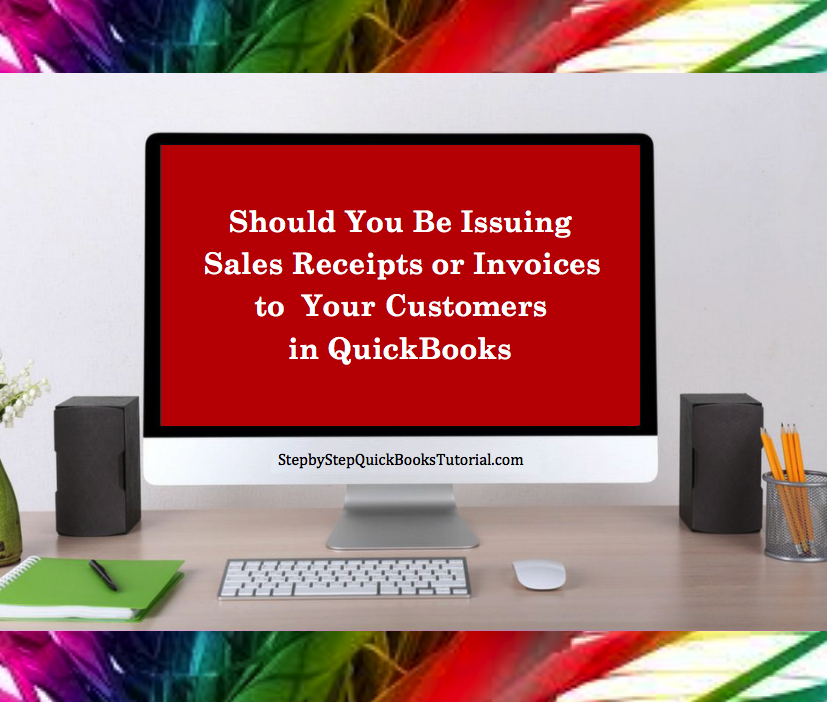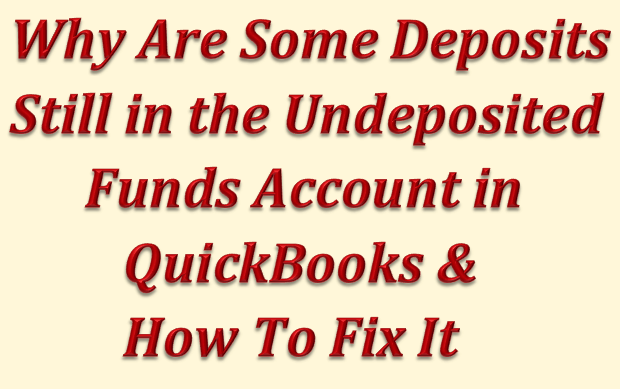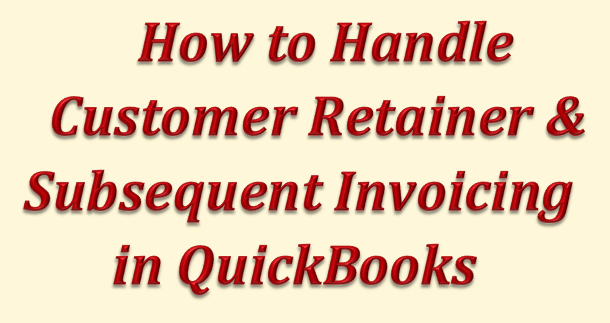by Marie | Mar 18, 2017 | Bookkeeping 101, Customer Setup & Management, Invoicing & Receivables, QuickBooks for Mac, QuickBooks for Windows, QuickBooks Online

Yesterday while consulting with my newest client  , the renowned owner of an upscale beauty Salon here in New York City, she asked a question that I was not expecting to hear asked. Meaning, I thought this would be something everyone knew the answer to. I mean, I did give her an answer, you know explained fully, but not before pausing and digesting it. So, I had to poll my Facebook group on this one, as I often do. Lo and behold, a whopping 68%
, the renowned owner of an upscale beauty Salon here in New York City, she asked a question that I was not expecting to hear asked. Meaning, I thought this would be something everyone knew the answer to. I mean, I did give her an answer, you know explained fully, but not before pausing and digesting it. So, I had to poll my Facebook group on this one, as I often do. Lo and behold, a whopping 68%  did not know the difference. I was wrong! I know we all have things in different fields of studies that we are not knowledgeable about but as far as the extent of common knowledge, what is and isn’t, do vary. So, in light of finding that out, I have decided to answer this specific question, “Should I be issuing customers sales receipts or Invoices in QuickBooks?” here so that others may be able to find the answer. That’s what I am about here at Step by Step QuickBooks Tutorial!
did not know the difference. I was wrong! I know we all have things in different fields of studies that we are not knowledgeable about but as far as the extent of common knowledge, what is and isn’t, do vary. So, in light of finding that out, I have decided to answer this specific question, “Should I be issuing customers sales receipts or Invoices in QuickBooks?” here so that others may be able to find the answer. That’s what I am about here at Step by Step QuickBooks Tutorial!
So, here’s the deal! If you are a business offering goods and/or services on credit to your customers, or allow for partial payments/payment deposits, then you should create and issue your customers Invoices. This will allow you to track your customers balances for Individual Invoices in the accounts receivables ledger, as well as have a comprehensive view of your total outstanding customer receivables. The Invoice connects the sales transactions to accounts receivables; the sales receipt on the other hand, does not.
If you require full payment at time of sale/service, then you should issue your customers Sales Receipts. Sales Receipts do not affect accounts receivables and thus will not allow for the tracking of any customer balances.
Businesses, such as my client’s beauty salon, that operate on a “buy/now pay/now” basis, do not need to Invoice their customers since they will not need to track payments owing to them – there won’t be any. Instead, they should issue sales receipts which is for the total amount of the sale. Thanks to today’s technological advancement, these businesses have the option of using a Point of Sale system, and most can be linked to an accounting software such as Intuit’s QuickBooks, and have the transactions easily downloaded to QuickBooks instead of manually.
So there you have it! Use an Invoice when you need to track customer balances, and a Sales receipt when you do not.
Don’t forget to like us on Facebook, follow us on Twitter and Linked In, plus One us on Google +, and leave a comment right here on this blog. Tall order, thank you!
by Marie | Aug 25, 2016 | Invoicing & Receivables, Preferences & Customization

Estimating is not only important for construction companies, but any company that produces Invoices, give quotes, bids, and proposals can use estimates in QuickBooks to get a handle on their job costing. Even if you do not provide your clients with estimates, you need to enter them in order to get the most out of the QuickBooks job costing reports. These reports, especially the “Job Estimates vs. Actuals” reports, are the key to making sure your existing job budgets are on track. They are also important when evaluating the accuracy of your estimates so you can make adjustments for future projects, as well as a requirement if you want to do progress invoice.
Setting Up Estimates in QuickBooks Contractor Edition
- Turn on the Estimate function at Preferences, then Jobs & Estimates.
- Create service items that match your project phases at Lists, Item List. You might also want to create sub-categories for materials and labor for tracking purposes, and use groups (see below) so they do not show up separately on your estimates and invoices.
- Create group items for items that you often sell together, this speeds up data entry and also allows you to hide details on estimates and invoices. For example, you could make a “Cupboards” group by grouping the items for all the materials and labor used. Each item in the Cupboards group has its own cost and selling price. When you choose an item for your estimate or invoice, you simply have to enter a quantity to get the total price for cupboards. You can also choose not to include the detail on your estimates and invoices by not checking the “Print items in group” box.
- Customize your estimates by clicking on the Customize button at the top of the Estimate form, then select Additional Customization.
- You can create multiple estimate forms for different needs and manage them at Lists, Templates.
- You can also memorize completed estimates that you use frequently by going to Edit, Memorize Estimate. You can also duplicate estimates at Edit, Duplicate Invoice.
- You can download free customized estimate templates from Intuit at: http://community.intuit.com/library/forms.
Entering Data for Accurate Reporting
- In order to get detailed estimate vs. actual job costing reports, you need to enter both estimated costs as well as revenue.
- You can either enter a $ or % markup to determine revenue, or you can enter revenue to determine the markup.
- If you want one line item for all revenue, enter $0 in the revenue column and add an additional item line for the revenue with no cost entered.
Linking Estimates with Invoices, Purchase Orders, and Sales Orders
- You can create invoices directly from the estimate by clicking on the Create Invoice button. You can invoice for the entire project or select progress invoicing. For progress invoicing, first turn on the function at Preferences, Jobs & Estimates. Then QuickBooks will give you the option of invoicing either for a fixed percentage of the entire estimate, or for different percentages of each line item on the estimate.
- You can also create sales orders directly from the estimate. First turn on the function at Preferences, Sales & Customers. Once you do, the purchase order button will be hiding under the Create Invoice button (click the down arrow to the right of it to see your options).
- You can also create purchase orders directly from the estimate. First turn on the function at Preferences, Items & Inventory. Once you do, the purchase order button will be hiding under the Create Invoice button (Click the down arrow to the right of it to see your options).
Change Orders & Estimates
A change order function is built into the contractors editions of QuickBooks. If you do not have the contractors edition, you can create new estimates for change orders, but this requires separate invoices. A better option is to create estimate & change order subtotal items and add change order items as separate line items on the original estimate.
by Marie | Apr 25, 2016 | Bookkeeping 101, Company Setup & Management, Invoicing & Receivables, QuickBooks for Mac, QuickBooks for Windows, QuickBooks Online, Reimbursements and Investments

The most common cause of this problem is that some items are using COGS for the income account. If you have invoices with items that have a COGS account as their income account, this will definitely cause a negative Cost of Goods Sold. Review the invoices hitting COGS and see which actual items are involved and then change the items in the item list. You have more credits than you do debits and those credits are coming from invoices hitting Cost of Goods Sold. COGS should be a debit with no invoices in the detail. You need to look at the invoices that are hitting COGS and see which exact line item it is. That is the item that has the incorrect account for income. That said, there a few other things that can cause the COGS to be negative.
Few things that can cause the COGS to be negative:
- Using an item on the invoice that has a COGS account as the income account
- Using an inventory item on a credit memo
- Using the COGS account as a credit on a journal entry
- Using the COGS account on a deposit
To fix the negative Cost of Goods Sold problem:
To locate and correct this issue, you need to start by generating a detail transaction report of your Cost of Goods Sold account(s). Once you have done that, double-click on all the negative transactions to see what exactly is causing the problem. You can also select the Reports button at the top of the transaction (not the top-level menu) and then select Transaction Journal. You can press Ctrl Y while the transaction is open to see what the underlying journal is.
You are looking for amounts in the Credit column for the COGS account – debits increase it, credits decrease it. If you are using items, inventory and other functionalities of QuickBooks, the direct problem could be one or more bills, checks, credit card charges, Invoices, credit memos, journal entries, or deposits. This report will show you exactly what is causing it.
In addition, you need to make sure that reimbursable expense is an Income account if you have reimbursables, and also ensure that the option is checked in the Preferences to track reimbursable expenses by going to Edit, Preferences, Time & Expenses, Company Preferences and make sure “Track reimbursed expenses as income” is checked.
Similar Articles:
by Marie | Mar 26, 2016 | Banking Setup & Management, Bookkeeping 101, Deposits & Undeposited Funds, Invoicing & Receivables, QuickBooks for Mac, QuickBooks for Windows, QuickBooks Online, Reconciliations

In order to use the undeposited funds correctly, it is important to understand how it really works. What are undeposited funds? Think of the Undeposited Funds account as an envelope where you keep checks until you take them to the bank. If you deposit more than one check or payment in a group deposit, you can enter those transactions so that your Bank Register matches your Bank’s monthly statement.
How to Accurately Use the Undeposited Funds Feature in QuickBooks
To use the undeposited funds accurately:
- When you record each customer payment, choose Group with other undeposited funds instead of Deposit to a Bank account.
- When you have all the checks entered and you are ready to actually deposit them in your bank, use Bank Deposits which is found under the Plus Sign Icon at the top of QuickBooks Online. In the desktop versions, go to Banking in the menu bar, and select Make Deposits.
- In the Bank Deposits or Make Deposit screen, click the drop-down to select the bank account you would like to deposit the funds to. This would of course be the bank account that you actually put the money in.
- Select the appropriate Date, and class or location if you are using them.
- You will see a Payments section. These payments listed are the ones you recorded and marked to go to undeposited funds. You can now select which of these payments should be included in this deposit to reflect the lumpsum deposit that was actually made to the bank.
- Click Save.
In order for this process to be successful, you must remember to go to the Bank Deposits window (in QuickBooks Online) or the Make Deposit window (in the desktop versions – Pro, Premier), and deposit the monies to the bank register in QuickBooks. Otherwise, they will just sit there, and if someone else is doing the reconciliations at the end on the month, they may actually enter those payments again directly to the bank register without realizing or even knowing that they were already in the Undeposited Funds account.
As you can see, there are still deposits in your undeposited funds account because the proper procedure was not followed. If the accounts were already reconciled for the period in which the transactions in the undeposited funds account relates, then the entries were entered twice – incorrectly increasing the revenue and may require an amended tax return to be filed if the tax for that period was already done.
I have explained indepth how to correct this in my articles:
by Marie | Mar 26, 2016 | Banking Setup & Management, Bookkeeping 101, Deposits & Undeposited Funds, Invoicing & Receivables, QuickBooks for Mac, QuickBooks for Windows, QuickBooks Online, Reconciliations

The main purpose of the undeposited funds feature in QuickBooks, is to give users the option of receiving customer payments and applying them to their Invoices on the dates received, while having a place to house them until they are ready to be deposited to the actual bank account. This is called “grouping deposits” in QuickBooks to reflect the lumpsum deposit that was made on a particular date. The undeposited funds feature can be a huge time saver, especially when it comes to reconciling bank accounts. You should absolutely use the undeposited funds feature:
- If you do not deposit each payment received from customers individually. If each deposit is done separately at the bank such as payments received from PayPal, Square, Shopify etc., there is no need to use the undeposited funds feature. If you receive customer payments via check or cash and you combine them to make one deposit into your bank account, then you need to post the individual payments to undeposited funds first. You will later go to Make Deposits and select the customer payments that made up the total deposits that were actually deposited on a specific date. You will need to ensure you change the date for the deposit in the “Make Deposit” window to reflect the date the deposits actually went into the bank. So, you use the undeposited funds when more than one payment is included in a deposit. That way the deposit in QuickBooks matches the deposit on your bank statement which will make it easier when it’s time to reconcile the bank account.
If you do not use the undeposited funds, then the amount is recorded directly in the check register. So, if you actually deposited several checks at once, you can imagine what a nightmare it becomes when you try to reconcile the checkbook. It creates lots of extra work – needlessly. If you use undeposited funds, then you “make deposits” that match the deposits you sent to the bank, which makes life much easier!
- When checks are received and not immediately deposited in the bank. This way, you will know the day the checks arrived and the day they were deposited. Using the undeposited funds feature in this case, will allow you to record the customer payments for the date in which they were received, and thus show accurate customer receivables while at the same time being able to deposit them on the date they were actually deposited. Without using the undeposited funds, it may be difficult to figure out what payments in QuickBooks make up what deposits on the bank statement when it’s time to reconcile the bank account.
When all is said and done, it is better to use the undeposited funds feature for all deposits, than to not use it for any deposits at all – especially deposits of more than one customer payments. You will have a more seamless, less time-consuming reconciliation process which is super important.
How to clear undeposited funds that were entered in error
If “in error” you mean that the transactions were to be sent directly to the bank account register instead of the undeposited funds account, then you can correct this either by: a) locating and editing the individual payments in question and changing the “Deposit to” field to the bank account. Or, b) you can deposit each payment in the “Make Deposit” window to the bank account by checking each one and changing the date to reflect the date it was actually deposited.
If “in error” you mean that the deposits were doubly entered; once directly in the bank via the check register, and again in the undeposited funds account, the cleanest, but also most time-consuming way to clear these items from the undeposited funds account or “Make Deposit” window is to open the corresponding deposits that were made without selecting from undeposited funds, click on the green Payments button, add the payment from undeposited funds, and then delete the incorrect payment that was entered. As long as the total deposit is unchanged, it will not unreconcile the previous reconciliations. However, if there are a lot of transactions in the undeposited funds account, it could take a really long time trying to resolve this. Why can’t I just delete them? You may ask. It is never okay to just delete anything from QuickBooks without knowing what other accounts and transactions may be affected. These customer payments in the undeposited funds account or make deposit window, may have been applied to Invoices. Deleting them will throw the accounts receivables out of balance, leaving the customers owing more in QuickBooks than they actually do in reality.
Bear in mind that most people who bypass undeposited funds use a revenue account to make the deposits, which means the revenue is possibly overstated – if those deposits are again applied to Invoices and are sitting in the undeposited funds account. So if you are trying to correct a period that you have already filed tax returns for, you will need to discuss this with your tax professional. You may need to file an amended tax return.
by Marie | Mar 25, 2016 | Bookkeeping 101, Customer Setup & Management, Invoicing & Receivables, QuickBooks for Mac, QuickBooks for Windows, QuickBooks Online

There are two types of retainer fees: one type is used as a downpayment where a customer or client pays a lawyer an amount, for example, and when the lawyer does work for the client he Invoices for that portion and offsets the Invoice total against the downpayment. The Invoice portions for work done are recorded as Income, with the corresponding total going to the retainer liability account decreasing the customer retainer balance. At the end of the year, depending on the agreement both party has, the retainer balance will either be returned to the customer or forward to the new year.
The other type of retainer is when a customer or client pays a company an amount of money for a period of time – say one year, so that they can have the privilege of using their service(s) during that period. This type of retainer in non-refundable, whether the client uses the service(s) or not, for this period. At the end of the period – usually a year, the retainer should be moved from the liability account to an Income account. This can be done via a journal entry by debiting the retainer liability account and crediting the Income account.
There are usually more than one ways to do things in QuickBooks, but this is the best option to handle customer retainer and subsequent invoicing in QuickBooks, and it can be used for both scenarios above:
- Create a Liability Account called something like “Retainer Liability” using a current liability account.
- Next, create an item called something like “Retainer” and map it to the retainer liability account you previously created.
- Use that item on the invoice or sales receipt for the retainer transactions. This will increase the retainer balance.
- After the work is performed, create an invoice or sales receipt like you normally would, with the appropriate sales items. Then add a line with a negative amount using the retainer item. This will increase sales Income and decrease the retainers account, as well as reduce the Invoice or sales receipt down to the remainder due.
Reconciling the Retainer Account
To reconcile the retainer account each month, go to your Chart of Accounts and reconcile your Retainers as you would a credit card or bank account. There is only one difference; enter your statement balance for the end of the month as ZERO. Then check off all the retainers that were charged and used up. The total of the checked items should equal zero, and the total amount owing should consist of all the unchecked items.
![]() , the renowned owner of an upscale beauty Salon here in New York City, she asked a question that I was not expecting to hear asked. Meaning, I thought this would be something everyone knew the answer to. I mean, I did give her an answer, you know explained fully, but not before pausing and digesting it. So, I had to poll my Facebook group on this one, as I often do. Lo and behold, a whopping 68%
, the renowned owner of an upscale beauty Salon here in New York City, she asked a question that I was not expecting to hear asked. Meaning, I thought this would be something everyone knew the answer to. I mean, I did give her an answer, you know explained fully, but not before pausing and digesting it. So, I had to poll my Facebook group on this one, as I often do. Lo and behold, a whopping 68% ![]() did not know the difference. I was wrong! I know we all have things in different fields of studies that we are not knowledgeable about but as far as the extent of common knowledge, what is and isn’t, do vary. So, in light of finding that out, I have decided to answer this specific question, “Should I be issuing customers sales receipts or Invoices in QuickBooks?” here so that others may be able to find the answer. That’s what I am about here at Step by Step QuickBooks Tutorial!
did not know the difference. I was wrong! I know we all have things in different fields of studies that we are not knowledgeable about but as far as the extent of common knowledge, what is and isn’t, do vary. So, in light of finding that out, I have decided to answer this specific question, “Should I be issuing customers sales receipts or Invoices in QuickBooks?” here so that others may be able to find the answer. That’s what I am about here at Step by Step QuickBooks Tutorial!







Recent Comments